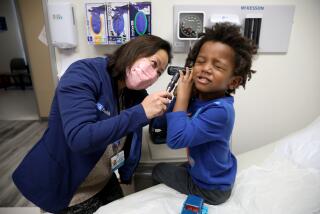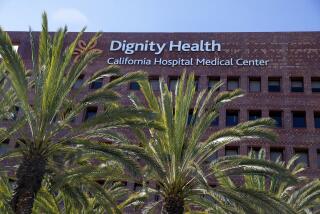Doctors give California an ‘F’ for lacking emergency room beds

- Share via
An updated national report on U.S. emergency medical care has again awarded California an “F” for lacking access to speedy treatment, noting that the state has the lowest number of hospital emergency rooms per capita — 6.7 per 1 million people — in the nation.
The America’s Emergency Care Environment report card, which gauges how well states support emergency care, was released Thursday by the American College of Emergency Physicians, an advocacy group.
Tracking 136 measures from sources including the U.S. Centers for Disease Control and Prevention and the Centers for Medicare and Medicaid Services, the organization called overcrowding in California emergency wards a “critical problem” and urged the state to increase its healthcare workforce and beef up a variety of facilities to reduce high wait-times for emergency services.
On average, Californians who were admitted into the hospital after visiting an emergency room waited more than five and a half hours from the time they arrived in the ER to the time they left it, the report said.
The state also had a shortage of inpatient and psychiatric beds in hospitals — another squeeze on emergency departments, which often “board” incoming patients until they can be routed to the correct hospital department, further restricting emergency care capacity.
The analysis arrives on the heels of Obamacare reforms designed to cut costs and improve results by steering patients away from visiting emergency rooms for routine care and guiding them instead to primary-care “medical homes” to manage chronic problems.
In theory, that could open up capacity for patients who require intensive urgent care. But there’s little reason to think implementation of the Affordable Care Act will ease the multitude of pressures emergency departments face, some physicians warned.
A study published Jan. 2 in the online edition of the journal Science found that ER use increased among low-income Oregonians who received government healthcare coverage through a Medicaid expansion program in that state.
An analysis of California’s low-income health program, a precursor to the current Medicaid expansion, also determined that emergency department use increased as the numbers of patients with subsidized healthcare access rose — but then declined over time.
Dr. Alexander Rosenau, an emergency physician in Pennsylvania and president of the American College of Emergency Physicians, said that a lack of sufficient primary care access for newly insured Americans was partially to blame for ER overcrowding.
“Right now there’s not adequate numbers of places to go,” he said.
The emergency doctors’ group looked at access to emergency care, and whether it was delivered in a safe and high-quality environment, a state’s medical liability environment, its public health and injury prevention programs, and disaster preparedness.
California was one of 21 states earning an F for access to care. It also received an F in that category the last time the ER doctors’ group produced its rankings, in 2009. (The national average in this category was D-: also a “failing grade,” the report noted.)
California earned better marks in the other four measures on the report, with a C- in quality and patient safety, a C+ for medical liability and a C- for disaster preparedness. The state performed particularly well in public health and injury prevention, earning a B+.
The College credited low rates of smoking and obesity and infant mortality, and enforcement of laws requiring the use of child safety seats, seat belts and motorcycle helmets.
“A lot of that is California culture. People tend to exercise well and eat better,” said Dr. Gregory Moran, an emergency room physician at Olive View/UCLA Medical Center in Sylmar.
Overall, California earned a C- and ranked 23rd among the states, an improvement over its D+ and 37th ranking in 2009. The District of Columbia ranked first this year, earning a B- overall and an A for emergency care access.
Rosenau, the president of the physicians’ group, said he worried that policymakers’ focus on emergency room wait times and crowding as a measure of Obamacare success would detract from the legitimate need for emergency care.
Citing CDC statistics, he said the vast majority of people who come into emergency departments need urgent treatment.
Sometimes primary care appointments aren’t available soon enough, or a physician might send a patient with an acute concern to the emergency room for better access to diagnostic tests or expertise, he said.
“We don’t want to keep people out of the ER,” Rosenau said. “The goal is to bolster primary care, not to take away from emergency medicine. If my child has asthma, and it’s midnight and he has 103 degree fever, where are you going to go?”
But for those in the L.A. area who are visiting emergency rooms and might be better served in a primary care setting, there aren’t sufficient options, said Dr. Marc Eckstein, a professor of emergency medicine at USC’s Keck School of Medicine at L.A. County-USC Medical Center.
“The ACA improves coverage but doesn’t do anything to address capacity,” he said. “There are only so many tables at the restaurant.”
Twitter: @LATerynbrown
More to Read
Sign up for Essential California
The most important California stories and recommendations in your inbox every morning.
You may occasionally receive promotional content from the Los Angeles Times.











